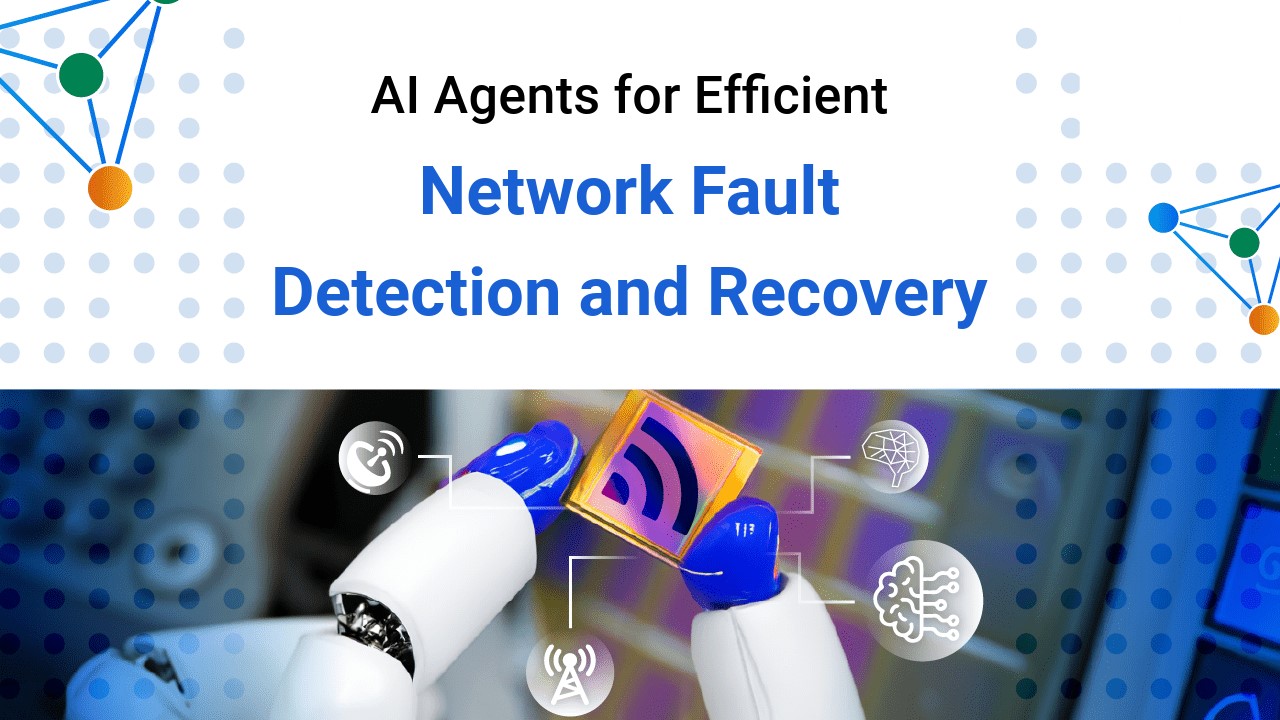Agentic AI-based network fault detection and recovery is revolutionizing the telecom industry by enabling proactive monitoring and rapid issue resolution. By leveraging real-time data analysis and machine learning, telecom providers can significantly reduce downtime and enhance service reliability. This transformation not only boosts operational efficiency but also leads to improved customer satisfaction and loyalty.
Let’s face it: network faults in telecom can be a real nightmare! Due to the increased complexity of the current networks, problems can easily occur and lead to significant problems. But what if the mistakes were to be fixed, by merely clicking a button? Enter Agentic AI-powered network fault detection and recovery! This approach translates to fewer parts being out of service and, therefore, increased reliability of service to clients. In this blog, we’ll explore how this technology is transforming the telecom industry, making it faster and more efficient to keep networks running smoothly.
What is Network Fault Detection and Recovery?
Telecommunication network fault detection and recovery is the process by which the occurred network problems are identified, isolated, and solved. This is a very important process since it enables service quality to be kept high and service interruption to be kept low. With the advent of AI-driven technologies, telecom companies can adopt more proactive strategies that enable them to detect anomalies and address potential issues before they escalate into significant outages. This shift not only improves operational efficiency but also enhances customer satisfaction by ensuring uninterrupted service.
A Brief Overview of Network Fault Detection and Recovery in Telecom
Network fault detection and recovery is critical for ensuring seamless communication in the telecom industry. AI-based solutions enable the implementation of automated fault detection and constant network monitoring of a huge amount of data. This also makes it easier to identify problems with the network, and when there is a break, everyone can quickly come up with ways of reheating. When it comes to the integration of AI in telecom companies, this approach can significantly improve operational standards since faults are detected and addressed before penetrating the customer domain.
Autonomous agents play a pivotal role in modern network fault detection and recovery strategies. These intelligent systems utilize real-time analysis of network data to identify anomalies and predict potential failures. By employing machine learning techniques, AI agents can continuously learn from historical data, improving their ability to detect faults accurately and swiftly. Furthermore, they facilitate root cause analysis (RCA), enabling telecom organizations to address existing problems and trends, preventing recurrence. If AI agents are integrated into the telecom provider’s network, then the speed and reliability of the telecom’s fault management can be improved.
Traditional vs. Agentic AI-based Network Fault Detection and Recovery
| Feature | Traditional Network Fault Detection and Recovery | Agentic AI-based Network Fault Detection and Recovery |
| Data Analysis Methodology | Manual processes with static insights | Real-time, dynamic data-driven analysis |
| Fault Detection Approach | Reactive fault detection | Proactive anomaly detection using AI |
| Response Time | Delayed response due to manual intervention | Instantaneous response with automated systems |
| Root Cause Analysis (RCA) | Often limited and time-consuming | Advanced RCA through AI-driven insights |
| Automation Level | Minimal automation | Significant automation leveraging AI agents |
Agentic AI Multi-Agent in Action
The Agentic AI multi-agent system demonstrates how AI-powered solutions can optimize network fault detection and recovery in telecom. This system incorporates various agents, each assigned specific tasks to enhance operational efficiency:
- Data Collection Agent: This agent collects network performance information from different layers, such as routers, switches, and user terminals. It also supports the collection of as much data as possible in order to practically monitor the network situation.
- Anomaly Detection Agent: Analyzing the collected data in real-time, this agent identifies unusual patterns that could indicate potential faults. By leveraging machine learning techniques, it continuously improves its detection capabilities, enhancing overall fault management effectiveness.
- Root Cause Analysis Agent: This agent is responsible for a detailed analysis performed in an effort to identify the causes of pointed faults. Adequate performance of root cause analysis (RCA) would ensure that more time is spent in finding why problems have occurred and, in so doing, reduce their recurrence.
- Fault Recovery Agent: This agent automatically performs recovery actions as soon as it discovers a fault and eliminates service downtime. In turn, it can perform pre-programmed recovery activities, as well as transfer exceptional incidents to human agent to simplify the fault recovery procedure.
- Performance Monitoring Agent: This agent constantly monitors the network performance parameters and is able to highlight desirable and undesirable patterns. Their monitoring prevents unsatisfactory levels and improves the reliability of service delivery and quality.
Use Cases of Network Fault Detection and Recovery
- Automated Network Monitoring: These agents are always monitoring the performance of networks and single out those that are defective. This capability reduces the time it takes to solve immensely, preserving the services’ reliability.
- Proactive Fault Management: Utilizing predictive analytics, telecom providers can identify potential issues before they escalate. This proactive approach, therefore, keeps management afloat since significant disruptions to the service offering are prevented.
- Dynamic Load Balancing: With performance data acquired in real-time, these agents can modify network loads and keep them from getting overloaded or triggering a failure. Due to this diversification, it is easy to manage the allocation of resources within the network.
- Service Quality Assurance: By conducting current monitoring and fast problem rectification, there is enhanced service quality, hence increased customer loyalty. All these suggest that if telecom companies are to achieve optimal performance all the time strong customer loyalty can be developed.
- Enhanced Security: A proactive use of AI Teammates in securing a system can detect the patterns that may depict a violation of security. This swift response capability is useful in maintaining the networks in a secure and efficient state as much as services are involved.
- Cost Reduction: Automating fault detection and recovery minimizes the need for extensive manual intervention, lowering operational costs while improving overall efficiency. This cost-effective approach enhances profitability for telecom providers.
Operational Benefits of Network Fault Detection and Recovery in Telecom
Integrating AI agents into network fault detection and recovery processes yields substantial operational benefits:
- Driving Efficiency: AI agents are expected to drive 80% of network monitoring tasks by 2025, allowing human operators to focus on more complex issues that require critical thinking and judgment.
- Boosting Productivity: The general trends indicate that, through automating the routine tasks of detecting faults and then managing to affect their correction, companies are likely to see their levels of productivity rise by about 30 percent.
- Enhancing Response Times: AI agents can reduce fault response times by 25%, ensuring that issues are resolved quickly to maintain service quality. Faster resolutions contribute to improved customer satisfaction.
- Improving Reliability: Under constant supervision and a preventive approach, AI agents can greatly minimize the instances of network outages, which in turn would improve reliability. Which in turn results in improved trust from the customers.
- Cost Savings: AI agents provide long-term cost savings, better services, and higher customer satisfaction and, thus, higher returns to the telecom business.
Technologies Transforming Network Fault Detection and Recovery
- Machine Learning Algorithms: These algorithms are crucial for identifying trends prior to a given time that would imply a specific fault. Their use improves the efficiency of anomaly detection.
- Predictive Analytics Tools: These tools help telecom providers predict ahead of time the network challenges that are likely to happen, thus taking preventive measures to prevent the disruption of the network.
- Real-Time Monitoring Systems: These systems offer real-time monitoring of the network by detecting any disparities and putting them right to increase network stability.
- Cloud Computing: This technology supports the scalable analysis and storage of data, which increases the efficiency of the implemented AI agents in the analysis of network data. It supports efficient network fault analysis.
- API Integration: This makes it possible for the diverse tools and platforms to interconnect so that once data is collected, it can be shared and used in the improvement of the fault management systems within the various tools and platforms.
- Security Protocols: Implementing robust security measures ensures that AI-driven systems are protected against cyber threats while maintaining compliance with industry regulations.
The Future Trends of Network Fault Detection and Recovery
- Hyper-Automation: Future developments will result in greater autonomy in such fault analysis and error rectification procedures, thus operating independently of the humans involved.
- Enhanced Collaboration: These agents will be more integrated with each other and provide information to enhance overall network performance. This improves the overall approaches used for fault management in the network.
- Integration with 5G: The rise of 5G networks will need refined AI-driven solutions to deal with increased complexity and traffic, necessitating advanced network fault detection capabilities.
- Ethical AI Practices: Developing ethical guidelines for AI use will ensure that fault detection and recovery practices are transparent and respectful of user privacy, fostering trust among customers.
- Greater Focus on User Experience: As telecom companies start incorporating AI solutions into their operations the focus will turn to using advanced technologies to make the client’s experience more efficient in terms of speed and reliability accordingly increasing satisfaction.
Conclusion: AI Agents for Network Fault Detection and Recovery
As we wrap things up, it’s evident that AI-driven network fault detection and recovery are transforming the telecom landscape. Gone are the days of prolonged downtimes and reactive troubleshooting that frustrate users! Instead, telecom providers can now swiftly identify and resolve issues, ensuring seamless service delivery. The future is exciting for the telecom industry, thanks to the innovative power of AI. With these advancements, maintaining a reliable network has never been easier — or more efficient.



